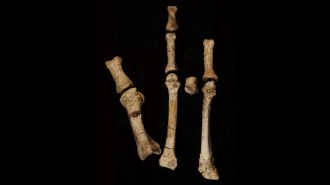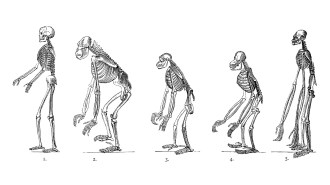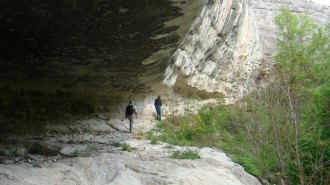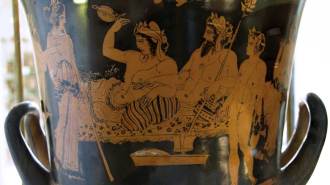The Pirahã Challenge
An Amazonian tribe takes grammar to a strange place
When Daniel L. Everett and his wife Keren Everett started spending 6 to 8 months each year with the Pirahã people of Brazil’s Amazon rain forest in 1977, they hoped to decipher a language that had long stumped missionaries in the region. By 1980, the two outsiders spoke the native tongue well enough to field an intriguing proposal from villagers: to teach them to count and to read. The villagers hoped that counting would prevent them from getting cheated when trading Brazil nuts and other goods for products such as tobacco and whiskey ferried through the area by Portuguese riverboat owners.
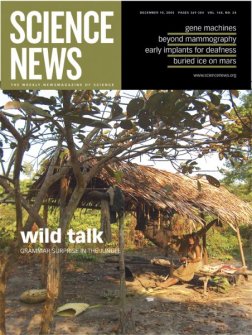
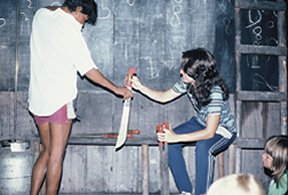
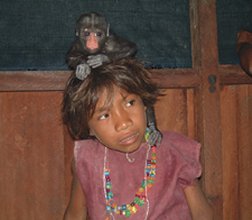
So for the next few months, Daniel Everett—a linguist affiliated with the University of Manchester in England and the Max Planck Institute for Evolutionary Anthropology in Leipzig, Germany—and Keren Everett, a missionary with linguistic training, ran evening classes in math and literacy for the forest dwellers. However, although the Pirahã know volumes about hunting and jungle survival, the group flunked both courses. None of the roughly 30 people who regularly attended classes learned to count to 10. None learned to add 3+1, or even 1+1.
Reading lessons ended abruptly when, after weeks of painstaking work, the students managed to read a Pirahã word aloud and in unison. Everyone laughed. Daniel Everett asked what was so funny, and his students responded that what they had just said sounded like their word for sky. That’s correct, Everett replied. The Pirahã immediately became agitated and asked to stop the lessons.
“Their motivation for attending literacy classes turned out to be, according to them, that it was fun to be together and I made popcorn,” Everett says.
Pirahã problems with reading, writing, and arithmetic stemmed not from slow-wittedness but from a cultural conviction about how to converse, Everett proposes. From the villagers’ perspective, talking should concern only knowledge based on one’s personal, immediate experience. No Pirahã refers to abstract concepts or to distant places and times.
As a result, Pirahã grammar bucks all sorts of linguistic conventions, according to Everett. The language lacks words for quantities, contains no standard words for colors, shows no sign of expanding or combining sentences through the use of clauses, rarely uses pronouns, employs just two tenses, and features only a few kinship terms, which refer mainly to living relatives.
Moreover, the Pirahã tell no creation myths and don’t make up stories or draw pictures. They believe in spirits that they directly encounter at times, “but there’s no great god who created all the spirits, in the Pirahã view,” Everett says.
Cultural mandates to express only one’s immediate experience and to shun outsiders’ knowledge have kept the Pirahã population, which now amounts to around 200 people, from learning other languages despite more than 200 years of regular contact with Brazilians and various Amazonian groups, he adds.
Yet despite the simplicity of its grammar, the Pirahã language matches other languages in complexity, Everett says. The villagers communicate almost as much by singing, whistling, and humming as they do with spoken words, he reports. Moreover, they convey a rich spectrum of emotions as they speak by systematically varying syllable intonations.
Everett lays out his argument for culture as a prime force in shaping the unusual Pirahã language in the August–October Current Anthropology. The eight scientific responses published with his article range from supportive to incredulous.
Everett expected criticism. His findings challenge the influential theory that all spoken languages draw on common grammatical rules. Proponents of that premise believe that the human brain comes equipped with grammar networks, as a biological consequence of Stone Age evolution.
Instead, Everett champions an approach that held sway in the first half of the 20th century. Influential anthropologists and linguists of that era argued that cultural values mold how people talk, just as a language’s expressive power shapes a culture’s traits. If that’s the case, basic elements of grammar can differ from one culture to the next, and cultural and social forces continually alter the fundamental rules of language.
“It took me 27 years to work up the courage to say these things about Pirahã grammar,” says Everett. Now, he’s standing his ground.
Counted out
In a particularly surprising twist, the Pirahã language—unlike any other recorded tongue—employs no numbers or other quantity terms, Everett contends. It lacks words that would translate as all, many, most, few, each, and every.
Words for whole and part are used only to describe specific experiences, such as a person’s plans to trade a whole snakeskin. If a piece of the skin is removed before the transaction, villagers still say that “the whole thing” was traded because they’re referring to the entire skin that was available at the time of the exchange.
A psycholinguist who studied the Pirahã people disagrees with Everett. Peter Gordon of Columbia University spent several months with the Everetts in the Amazon testing Pirahã counting abilities. Gordon asked villagers to line up AA batteries so that they matched, in number, arrays of 1 to 10 objects that he presented. Other tasks included asking volunteers to indicate when all the nuts that Gordon had deposited in a can and extracted one at a time had been removed.
Pirahã counting words consist of one, two, and many, with the word for one sometimes meaning “small,” Gordon reported in the Oct. 15, 2004 Science. Given this limited counting vocabulary, math problems with quantities greater than three usually stump the Pirahã villagers, he found.
Some other languages, such as Warlpiri in Australia, also use a one-two-many counting system, Gordon notes.
Everett, however, argues that Gordon misinterpreted three Pirahã words that are easy to confuse with numerals. The words really mean “small size or amount,” “large size or amount,” and “cause to come together,” Everett holds. The last word refers to any group consisting of individual elements, such as foreigners camping in a nearby jungle.
A related dispute concerns Pirahã color terms. Everett says that villagers use whatever descriptive turns of phrase strike them as appropriate when talking about particular colors rather than designated words for each color.
However, another of the few researchers who speak the Pirahã language reported that 25 of the villagers named colors on a palette that he showed to them. This work, conducted by Steve Sheldon of the Summer Institute of Linguistics in Dallas, was part of a study that tested people in 110 non-industrialized populations. All the groups named basic colors using words that correspond to white, black, red, green, yellow, and blue. The team, led by linguist Paul Kay of the International Computer Science Institute in Berkeley, Calif., reported its findings in the June 7 Proceedings of the National Academy of Sciences.
As in the counting studies, the color-naming investigation got lost in translation, Everett responds. He says that Kay and Sheldon misinterpreted descriptive phrases for colors as color words. For instance, the Pirahã word they cite as red actually means “bloodlike” and the alleged word for black really means “dirty blood.”
After reexamining his data, Sheldon now agrees. Pirahã participants in his experiment openly discussed color responses with their comrades, despite having been told not to do so, he notes. That could explain why volunteers came up with common terms for each color.
“For those who don’t speak the Pirahã language, Everett’s conclusions sound far-fetched,” Sheldon says. “I do not believe they are.”
In the now
The extreme focus on talking about immediate experience in Pirahã culture not only eliminates counting and color terms, in Everett’s opinion, but it also strips the language of recursion. This common linguistic device consists of embedding sentences—clauses—within other sentences. By extending and recombining ideas through the use of clauses, speakers can generate a very large number of expressions from a finite repertoire of sounds and words.
The lack of recursion “is perhaps the strangest feature of Pirahã language,” Everett says.
For instance, the Pirahã have no way to say, “When I finish eating, I want to speak to you.” The closest corresponding expression best translates as “I finish eating. I speak to you.” The speaker employs two independent sentences rather than an initial clause and additional information making it meaningful.
Recursion expands the time scale of what one can talk about. The ancient past and the distant future become fair game. That’s forbidden verbal territory among the Pirahã, Everett emphasizes.
This cultural habit has also shaped the Pirahã tendency to speak in two basic tenses, he adds. These tenses distinguish between events that either are or are not in the immediate control or experience of the speaker.
In another limitation of the language, Pirahã kinship terms refer only to known, living relatives. They tend to refer, for example, to a grandparent by the individual’s name rather than as a parent of a parent.
A focus on immediate experience goes a long way toward explaining why the Pirahã tell neither creation myths nor stories about the ancient past, Everett adds.
Everett suspects that individual Pirahã ponder past events and think in other recursive ways but can’t express such thoughts with their language.
The possible existence of a language devoid of recursion strikes a sensitive nerve among linguists. Some, such as W. Tecumseh Fitch of the University of St. Andrews in Edinburgh, and Noam Chomsky of the Massachusetts Institute of Technology (MIT), regard recursion as a crucial element of language.
In an upcoming Cognition, Fitch and his colleagues briefly address the challenge that Pirahã speech presents to their perspective. If it’s truly recursionfree, then they regard it as a rare exception. “Our language faculty provides us with a toolkit for building languages, but not all languages use all the tools,” they say.
MIT linguist David Pesetsky, who attended a lecture on the Pirahã given by Everett at a scientific meeting in September, says that the language appears to operate much like languages elsewhere on general characteristics, such as word order. He’s unconvinced that the language lacks features found in all others.
Stephen C. Levinson of the Max Planck Institute for Psycholinguistics in Nijmegen, the Netherlands, offers a different view. He holds that a more thorough consideration would turn up the missing parts of grammar rather than making the Pirahã “sound like the mindless bearers of an almost subhumanly simple culture.”
Not so special
Perhaps the most common question that Everett fields from his critics concerns the apparent uniqueness of Pirahã speech. Why, they ask, is this the only known language to display such an unusual grammar?
His response: Pirahã probably isn’t so special. Everett lived within the tribe for several field seasons before he started to speak its language well and has continued to hone his fluency over the equivalent of 7 years. Hard-earned intimacy with the language revealed subtle word meanings and structural elements that are easy to miss or misinterpret, Everett says.
Only rarely have researchers achieved fluency in a language spoken in a non-industrialized population and then undertaken long-term studies of the tongue, he adds. Such studies would probably uncover many similarities to Pirahã grammar, he says. Other unique facets of grammar might also come to light.
Remarks Everett, “If languages can differ in fundamental ways across cultures, then the argument for saving and documenting all of them becomes much stronger.”



